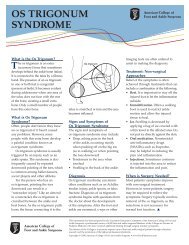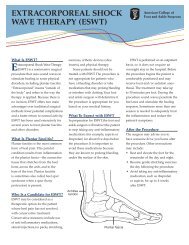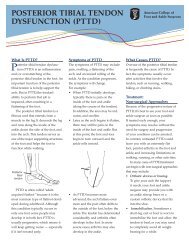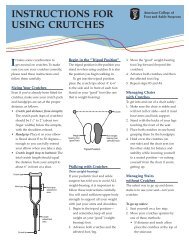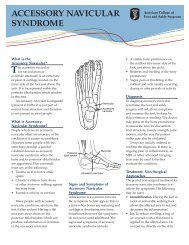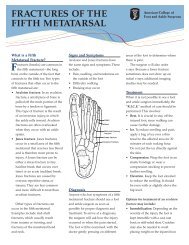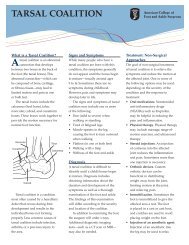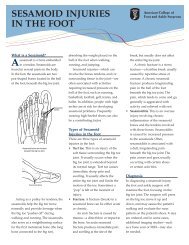CAVUS FOOT (HIGH-ARCHED FOOT)
CAVUS FOOT (HIGH-ARCHED FOOT)
CAVUS FOOT (HIGH-ARCHED FOOT)
Create successful ePaper yourself
Turn your PDF publications into a flip-book with our unique Google optimized e-Paper software.
Treatment: Non-Surgical<br />
Approaches<br />
Non-surgical treatment of cavus foot<br />
may include one or more of the<br />
following options:<br />
• Callus care. The surgeon often<br />
trims the calluses and<br />
recommends wearing small pads<br />
around the calluses to reduce<br />
pressure and pain. Patients<br />
should never attempt to trim<br />
calluses themselves, since this<br />
could do more harm than good<br />
and possibly result in an<br />
infection.<br />
• Orthotic devices. Custom orthotic<br />
devices that fit into the shoe can<br />
be beneficial because they<br />
provide stability and cushioning<br />
to the foot.<br />
• Shoe modifications. High-topped<br />
shoes support the ankle, and<br />
shoes with heels a little wider on<br />
the bottom add stability.<br />
• Bracing. The surgeon may<br />
recommend a brace to help keep<br />
the foot and ankle stable. Bracing is<br />
also useful in managing foot drop.<br />
When is Surgery Needed?<br />
If non-surgical treatment fails to<br />
adequately relieve pain and improve<br />
stability, surgery may be needed<br />
to decrease pain, increase stability,<br />
and compensate for weakness in<br />
the foot. Surgery is also considered<br />
for cases that are likely to get<br />
worse—even if there is currently<br />
no pain or instability. In these<br />
instances, the goal of surgery is to<br />
help reduce the severity of<br />
future problems.<br />
The surgeon will choose the best<br />
surgical procedure or combination of<br />
procedures based on the patient’s<br />
individual case. In some cases where<br />
an underlying neurologic problem<br />
exists, surgery may be needed<br />
again in the future due to the<br />
progression of the disorder. ▲<br />
This information has been prepared by the Consumer Education Committee of the American College of Foot and<br />
Ankle Surgeons, a professional society of 6,200 foot and ankle surgeons. Members of the College are Doctors of<br />
Podiatric Medicine who have received additional training through surgical residency programs.<br />
The mission of the College is to promote superior care of foot and ankle surgical patients through education,<br />
research and the promotion of the highest professional standards.<br />
Copyright © 2007, American College of Foot and Ankle Surgeons • www.FootPhysicians.com



